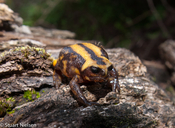|
Balebreviceps hillmani Largen & Drewes, 1989
| family: Brevicipitidae genus: Balebreviceps |
 © 2023 Stuart Nielsen (1 of 3) |
|
|
|
Description Balebreviceps hillmani is differentiated from other Brevicipitidae by the presence of posteriorly curved clavicles and absence of middle ear elements. It also has a unique structured palate. The fifth metatarsal has a uniquely elongated proximate epiphysis. Both Balebreviceps and Probreviceps have noticeable longer hind limbs in comparison to Breviceps. Osteologically, the nasals of Balebreviceps are smaller and broadly separated, where as in Probreviceps, the nasals are larger and almost meet in the midline (Largen and Drewes 1989). In life, expect to see a deep purple or brown color on the dorsal side, with a pair of pale yellow or golden stripes located dorsolaterally. The dorsal margins of the head are outlined by a similar pale-colored marking that extends all the way to the tip of the snout. The sides of the head are dark grey-brown with grayish-yellow spotting. The dorsolateral lines can often expand towards the midline and onto the head, so that the dark color in-between turns into a blob or completely disappears depending on the thickness of the lines. The hindlimbs are similar in color to the dorsolateral strips, and often even have a hint of orange. Sometimes they may also be a dark grey-brown color like the forelimbs. The forelimbs may also have dirty yellow blotches. The soles of the hands and feet are flesh colored and occasionally a pale grey. The ventral side is dirty yellow for the most part, although the belly is sometimes pale grey and the chest is often a pinkish color. In alcohol, expect to see the same dark purple brown color on the dorsum, and the dorsolateral stripes become a dirty cream color. The flank area is also a purplish-brown color with yellow or cream colored spotting. The venter is a cream color with markings that are a darker, purple or brown color (Largen and Drewes 1989).
Distribution and Habitat Country distribution from AmphibiaWeb's database: Ethiopia
Life History, Abundance, Activity, and Special Behaviors All Balebreviceps hillmani live an entirely terrestrial life cycle. Male Balebreviceps hillmani lack a vocal sac and both males and females lack an auditory apparatus, and thus this species is insensitive to airborne vibrations. Balebreviceps hillmani should be found above ground, as they do not seem to have a need to burrow. However, they do squeeze themselves into narrow crevices by using force exerted by the backward thrusts from the hindlimbs. At such a high elevation, there is minimal danger from predators, and the very moist environment removes the risk of desiccation (Largen and Drewes 1989). Trends and Threats The Ethiopian Wildlife Conservation Organization is taking action by learning more about the forest in order to make educated recommendations for its protection (Largen and Drewes 1989). Possible reasons for amphibian decline General habitat alteration and loss Comments Balebreviceps gets its name after the Bale Mountains in southern Ethiopia (Largen and Drewes 1989).
References
IUCN SSC Amphibian Specialist Group. (2013). Balebreviceps hillmani. The IUCN Red List of Threatened Species. Version 2014.3. www.iucnredlist.org. Downloaded on 24 November 2014. Largen, M. J. and Drewes, R. L. (1989). ''A new genus and species of brevicipitine frog (Amphibia, Anura, Microhylidae) from high altitude in the mountains of Ethiopia.'' Tropical Zoology, 2, 13-30. Originally submitted by: Tamar Garcia (first posted 2014-11-19) Edited by: Ann T. Chang (2014-11-24) Species Account Citation: AmphibiaWeb 2014 Balebreviceps hillmani <https://amphibiaweb.org/species/2369> University of California, Berkeley, CA, USA. Accessed Nov 25, 2024.
Feedback or comments about this page.
Citation: AmphibiaWeb. 2024. <https://amphibiaweb.org> University of California, Berkeley, CA, USA. Accessed 25 Nov 2024. AmphibiaWeb's policy on data use. |



 Map of Life
Map of Life